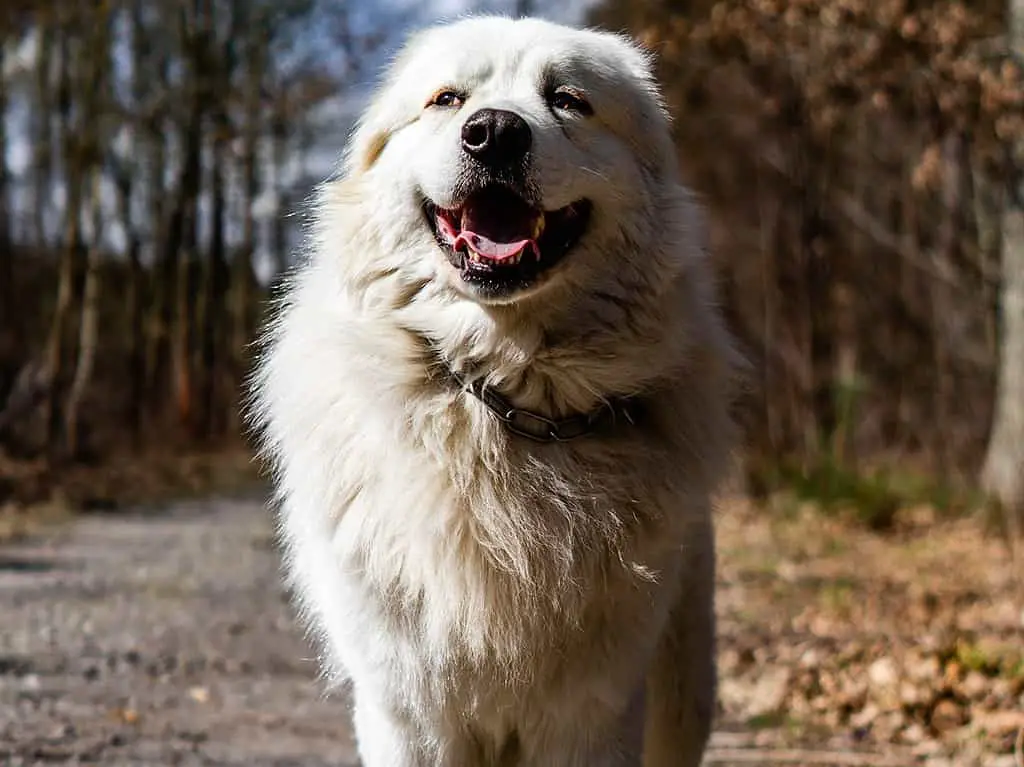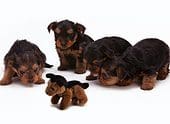Are you looking for a pooch that is as lively as it is cuddly? Meet the Whoodle! This cross between a Poodle and Soft-Coated Wheaten Terrier loves to run around and play but also appreciates snuggling with you. Their long, curly coats will keep you warm on cold winter nights.
You’ll quickly discover why this breed is well-loved by many. It won’t take long for you to smile from ear to ear, seeing your Whoodle bonding with your kids and family. That’s right; their friendly and affectionate nature will win your heart.
You’ll also find yourself taking lots of snapshots. Those folded ears and dark eyes just make them picture-perfect!
But then again, you can’t earn those warm hugs and Insta-worthy pics if you don’t take care of your Whoodle properly. And that’s where we come in. Here’s everything you need to learn if you’re dedicated to owning a Whoodle.

Quick Facts: Whoodle
Height
14 - 20 inchesWeight
20 - 45 poundsLifespan
12 - 15 yearsBreed Size
medium (26-60 lbs.)Breed Type
mixedBreed Group
companionTemperament
anxious, friendly, playful, affectionate, active, intelligentGood With
families, other dogs, catsIntelligence
highShedding
infrequentExercise Needs
highBarking Level
highEnergy level
highDrool Amount
lowCoat Type
long, curlyCoat Patterns
sable, tri-color, phantom, merleColors
black, cream, redOther Characteristics
apartment-friendly, hypoallergenic, requires lots of grooming, not a big barkerWhoodle Highlights
- Woodle dogs are not big barkers. They may make better pets for those who don’t like lots of noise or people who work late at night.
- Whoodles are not recommended for those who have a lot of responsibilities that keep them from being able to take their dog on regular walks.
- They make excellent family pets and are very affectionate. But as loving dogs, Whoodles can get anxious when separated from their owners for long periods.
- The Poodle qualifies as one of the most intelligent breeds, and the Soft-Coated Wheaten Terrier isn’t far behind. That being the case, the Whoodle can be trained quickly and easily.
- Their long, curly coats can require a lot of upkeep.
- Whoodles live longer than their purebred counterparts.
- Whoodles are hypoallergenic dogs, so people with allergies cans safely own them.
History
At the start of the 20th century, Soft-Coated Wheaten Terriers and Standard Poodles were crossbred to produce the Whoodle. The goal was to create a dog that had the beautiful fur of the Soft-Coated Wheaten Terrier and the workability of the Poodle.
Unfortunately, like most other hybrid dogs, its history is largely unknown. It is a mystery who started the cross or why. But we can look at the history of each Whoodle’s parent breeds.
Australian Shepherd

The origin of the Anatolian Shepherd Dog appears to date back to hunting dogs from Mesopotamia, suggesting a very ancient breed. Through the ages, they have been adapted to best suit their environment and responsibilities; this process was heavily impacted by factors such as duties, climate, and lifestyle.
This breed can be found in its homeland in Turkey, where it has traditionally served as a herder’s friend and guardian for livestock; it was selectively bred to share qualities with the farm animals so that potential threats would not be able to differentiate these shepherd dogs from their prey.
During the 1970s, breeders in Western countries began to exhibit increased interest in Anatolian Shepherds. They subsequently ignited a process by which landrace natural breeds could steadily be transformed into modern variants; this was achieved through various means, such as documenting origins from particular ancestors and forming breed standards that set forth requirements.
The first kennel likely arrived in America during the late 1930s, when they became part of a study that was intended to find what type of dog would make an exemplary sheepdog.
Great Pyrenees

It is believed that the Great Pyrenees descended from a collection of predominantly white mountain flock guard canines dating back to around 10,000 or 11,000 years ago in Turkey. This theory is further supported by the likelihood that these large white dogs were brought to the Pyrenees Mountains with their herdsmen and domestic animals dating as far back as 3000 BC.
In 1931, Mr. and Mrs. Crane imported a number of Great Pyrenees in an effort to establish the breed in North America with the formation of Basquaerie Kennels at Needham, Massachusetts; their dedication to the cause enabled the breed to remain robust and continue developing. They also acquired valuable breeding stock from Europe prior to World War II restricting access from the continent.
On February 1935, the American Kennel Club approved the official standard of the Great Pyrenees, more commonly called Pyrs. Described by its characteristics as a kind, intelligent and regal breed of immense size, Pyrs can be a strong addition to any home.
Appearance

These dogs have a muscular build, with folded ears and dark eyes. Like other crossbreeds, their overall appearance can be a mix of the Poodle and Soft-Coated Wheaten Terrier parents.
Whoodle Size
Because the Poodle parent comes in three sizes (miniature, medium, or standard), the Whoodle also come in these sizes. On average, the size of a Whoodle is about 14 to 20 inches tall and weighs about 20 to 45 pounds. Therefore, they generally are categorized as a medium-sized breed.
Whoodle Colors
The coat of these dogs can be any color, but the most common ones we see are black, red, and cream (wheaten).
The solid black remains solid black as the Woodle puppy matures.
Red can eighter lighten into a smokey red or a toffee color.
Puppies born cream typical matures into rich apricot.
Coat
Their coats are usually long and curly. However, their patterns can vary — merle, tri, phantom, and sable.
Merle: These irregularly shaped patches in your puppy’s skin vary in size and shade. Whether they remain or fade away depends on their size and shade. The smaller and lighter patches fade into the dog’s primary color, while the bigger and darker ones remain and eventually fade into smoky gray.
Phantom: Black, red, and cream are the primary colors of the Woodle puppy, but the legs, chest, eyebrows, and backside of their legs are tan.
Tri: This coat pattern is similar to Phantom except that there’s a white around the pup’s feet and a white area on the chest.
Sable: This is the most common coat pattern and can be distinguished by gray patches around the muzzle and ears. Some hair tips are a darker version of the Woodle’s main coat color.
Personality




Friendly
Whoodles appeal to everyone because of their friendly character. They will often greet people when they walk past and be happy to be around them. This makes people feel good, and it is often one of the first things that strangers and friends notice about Whoodles.
Loving
These dogs are not destructive and aggressive, all thanks to their gentle and loving nature. They enjoy being around people and being treated well. This makes them great companions, and people are drawn to them in return.
Additionally, Whoodles have a soothing effect on people. If you want a furry friend that you can connect with emotionally, raise a Doodle.
Anxious
As we said, Whoodles like to be close to their owners. But there’s a downside: they become anxious when left alone for hours on end.
Separation anxiety can make these dogs nervous and irritable and may cause them to bark or refuse to eat. But don’t worry; there are ways to manage your dog’s anxiety.
First, establish a routine, including feeding and walking times. This will help your dog feel more at ease and less anxious when changes occur.
Also, create a safe space. This could be a small room or any area in the house that is comfortable for him and should include items he loves (such as toys or treats).
Separation anxiety can be a frustrating experience for both you and your dog, but it will eventually subside. Be patient, and allow your dog time to adjust.
Finally, reinforce positive behavior. If your dog is often good during routine separations, reinforce that behavior. This will help to keep your dog calm and relaxed the next time you leave him alone.
Not A Big Barker
Do you want a dog that doesn’t bark often? Look no further than the Whoodle. These dogs are not big barkers, so they’re less likely to disrupt your sleep. They’re also less likely to be aggressive towards people who come to your house.
Whoodles make it easier for you to relax and get some rest. Also, owning a Whoodle can save you time and energy. For example, when your dog is barking, you must respond to the noise immediately. This can be a time-consuming task, and it can also be distracting if you’re working from home.
Active
Whoodles make great family pets because they are highly active. They love to play and have a lot of energy. As well as being highly active, these dogs are always ready to learn new tricks and are usually very obedient.
Health
The Whoodle dog is a healthy breed, often less prone to developing certain congenital conditions than purebred dogs. But that doesn’t mean the Whoodle is immune to developing certain conditions – all breeds are susceptible to several different diseases.
Owners should know that Whoodles can be affected by cataracts, allergies, ear infections, progressive retinal atrophy, Addison’s disease, and hip dysplasia.
Cataracts
Did you know that cataracts are a big problem in Whoodles as they age? In some cases, the condition can cause your Whoodle’s eyesight to deteriorate, and if left untreated, it can even lead to blindness. Symptoms of cataracts include adopting coping behaviors due to sight loss, irritation, eye inflammation, and cloudy eyes.
Don’t hesitate to contact your veterinarian if you notice any cataracts in your dog’s eyes. Cataract surgery is a significant option for dogs with vision impairment.
Allergies
While not usually dangerous, dogs’ allergies can cause many discomforts. The most common symptoms are itching, fur loss, compulsive scratching, rubbing the face, chewing on the feet, and excessive licking.
If you notice any of the following symptoms in your Whoodle, please make an appointment with your veterinarian as soon as possible. There are many possible causes for these symptoms, and getting help soon will ensure the best outcome.
Ear Infections
Ear infections in Whoodles can be a real pain. They don’t always need veterinary treatment, but you need to take them to the vet for treatment if they don’t get better on their own.
The common ear infection symptoms in dogs are scabs in the ears, itchiness, constant head shaking, pain, ear canal swelling, unpleasant odor, and dark discharge.
Hip Dysplasia
This condition is commonly due to a hip deformity, causing osteoarthritis, mobility issues, and pain. Whoodles with hip dysplasia may not show clinical signs until they’re older. Therefore, early detection is vital in preventing hip dysplasia in your pet. By screening them for the condition early, you can take action to correct the hip deformity before it becomes a bigger problem.
Note: To avoid taking home an unhealthy Whoodle, we recommend only buying from reputable breeders and requesting health certificates or health screenings. If you can meet the dog parents, the better.
Lifespan
If you take good care of a Whoodle, they will do the same – providing you with long-term companionship. They can live up to 15 years, which is generally considered a long life for a dog.
Care
These dogs need to be well-taken care of, just like any other breeds, and you can do a few things to make sure that happens.
One of the first things you should do is ensure your Whoodle gets the proper amount of exercise. An inactive dog will quickly become overweight and may develop health problems. An excellent way to ensure your Whoodle gets the exercise she needs is to take her for a walk every day.
Play with your Whoodle often. They love to get their energy out, so ensure to give them plenty of opportunities to do so.
Finally, provide your Whoodle dog with a comfortable place to sleep. This could be a bed in your room or a kennel outside. Ensure that the area is clean and that the Whoodle has enough space to move around.
Diet
Because Whoodles love to play and go on long walks, you need to give them enough food to support their active lifestyle. Compared to sedentary dogs, Whoodles will need more calories in their diet.
You can meet their increased caloric demands by increasing the kibble you give them or switching to a higher fat diet. A higher fat diet can include small portions of fish, chicken liver, and lean beef.
Read also: 12 Worst Dog Food Brands To Avoid This Year
But remember: Do not abruptly switch to a higher fat diet as this can cause gastrointestinal upset such as low appetite, diarrhea, and vomiting. Instead, do the transitioning gradually so your Whoodle’s system can keep up with the change. Ideally, these transitions should happen over one week, with you slowly incorporating the higher fat diet into your dog’s current diet.
Grooming
If you’re familiar at all with the parent breeds, you know that they both have teddy bear-like coats that are non-shedding. However, this doesn’t mean that these dogs don’t require some regular grooming. For example, a Wheaten Terrier’s “fluffy” undercoat can develop mats if not groomed regularly, while a Poodle’s naturally curly hair can get tangled easily. That said, you need to constantly brush their hair to prevent mats from forming.
Whoodle Puppies

Since the Whoodles come from two purebred dogs of different breeds, they belong to the first-generation hybrids. Although this usually leads to a competent puppy, it can also mean that its physical appearance can vary. Some Whoodle puppies might look more like the Poodle or Wheaten parent, while others might share traits with both.
As for behavior, these puppies are generally well-behaved and intelligent, making their training and socialization relatively easy.
Read also: Help! My Puppy Has Hiccups All The Time – Is That Normal?
Children and Other Pets
Whoodles are great for children and other pets because they are friendly and playful. They are also very obedient, so you will not have to worry about them getting out of control.
If you’re having second thoughts about your ability to keep up with the Whoodle’s need for entertainment and attention, you can look at a more laidback breed: the French Bulldog.
Are you sure about raising this crossbreed? If so, check out the following rescue groups.
Rescue Groups
It can be hard to find Whoodle rescue groups as this mixed breed is relatively new. However, these dogs may have found their way into Poodle and Soft-Coated Wheaten Terrier rescue shelters.
Whoodle FAQS
Does a Whoodle shed?
Yes. These dogs shed, but the amount of shedding is very manageable. They’re also hypoallergenic dogs, producing less dander and saliva that can stimulate allergies in people.
How smart are Whoodles?
The Poodle ranks second in the list of most intelligent dog breeds. So what does this mean for Whoodles? They can learn new commands with just a few repetitions. This is an incredible testament that they take after the Poodle’s intelligence and trainability.
Are Whoodles cuddly?
In the old days, Poodles depended on cuddling to stay warm in cold weather. Now that they’re just lap dogs, they still rely on this natural way to keep warm.
The Whoodles aren’t any different; they love to snuggle up close with their human friends for warmth.
Who should not own a Whoodle dog?
Being high-energy dogs, Whoodles need daily exercise to stay happy and healthy. Therefore, you should not get this breed if you’re not into an active outdoor lifestyle or are gone most of the day.
Are Whoodles good for seniors?
No. Whoodles may be too rough for seniors or those with mobility problems and cause these people to injure themselves. Additionally, seniors may be less able to keep up with the fast-moving energy of a Whoodle. They may jump and bark continuously or run around and play constantly.
The best dogs for seniors are those who are more laidback and will stay nearby but not be constantly active.
Whoodle Fun Facts
- These furry friends are quick learners and make excellent therapy dogs and service dogs because of their easy-going nature, quick-to-learn attitudes, and hypoallergenic coats.
- Despite their rarity, some of these dogs are making their mark on social media.
- Whoodles are very smart dogs, but some can also carry streaks of independence and stubbornness.
References
Ogata, N. (2016). Separation anxiety in dogs: What progress has been made in our understanding of the most common behavioral problems in dogs?. Journal of Veterinary Behavior, 16, 28-35.
Colliard, L., Ancel, J., Benet, J. J., Paragon, B. M., & Blanchard, G. (2006). Risk factors for obesity in dogs in France. The Journal of nutrition, 136(7), 1951S-1954S.
Fries, C. L., & Remedios, A. M. (1995). The pathogenesis and diagnosis of canine hip dysplasia: a review. The Canadian Veterinary Journal, 36(8), 494.
Mooney, C. T. (2007). Addison’s disease (Hypoadrenocorticism) in dogs. Companion Animal Practice, 17, 167.




